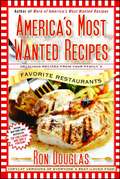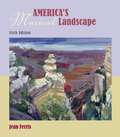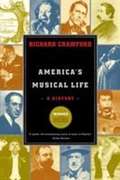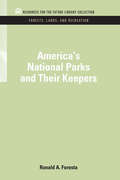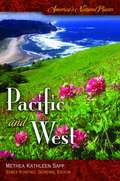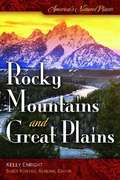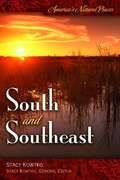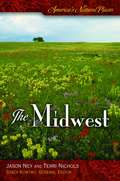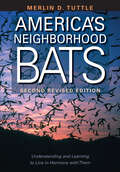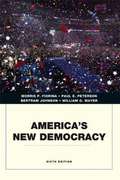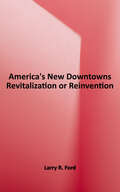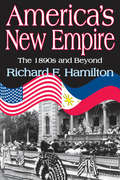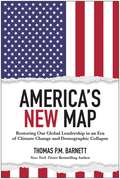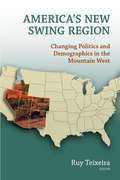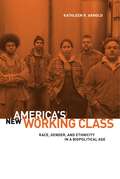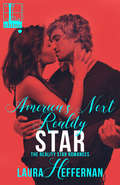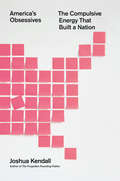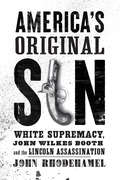- Table View
- List View
America's Most Wanted Recipes: Delicious Recipes from Your Family's Favorite Restaurants (America's Most Wanted Recipes Series)
by Ron DouglasRon Douglas reveals the secret recipes from America’s restaurants— The Cheesecake Factory™, The Olive Garden™, P.F. Chang’s™, Red Lobster™, and many more—and shows readers how to make them at home for a fraction of the price.The average American family eats out three or more times per week, which translates into hundreds of dollars spent on food each month. In these hard economic times, families simply can’t afford to keep paying these high prices. And Ron Douglas has spent the past five years of his life ensuring that we won’t have to. With the help of a test kitchen and more than 45,000 tasters, he uncovered the carefully guarded recipes of the most popular meals at restaurants across the country. With his easy-to-follow steps, families can now enjoy the meals they love most at a price they can actually afford. KFC’s Famous Fried Chicken, Chili’s Southwest Chicken Chili, Olive Garden’s Breadsticks, and Cheesecake Factory’s Oreo Cheesecake are just a few of the many famous and delicious recipes included. And because each recipe has been tested by Ron’s incredible network of tens of thousands of testers, they are indistinguishable from the originals. These best-kept secrets can save you thousands of dollars a year and will put delicious meals on the table that the whole family will enjoy.
America's Musical Landscape
by Jean FerrisThis textbook for music appreciation undergraduates surveys American music, relating it to the other arts and social and cultural contexts. Ferris (music history and appreciation, Arizona State U.) first explains the elements of music, then takes the reader on a chronological tour of American music, from North American Indian and folk music to contemporary mainstream concert music. Along the way, religious and secular music are discussed, as well as nineteenth century popular and concert music; country, folk, jazz, Latin music, and rock and roll; and musical theater, film music, and American opera. Listening charts are incorporated. This edition has been updated and reorganized, the amount of vernacular music has been expanded, and the recordings have been updated to match. Timelines are also new. No bibliography is provided. Annotation ©2006 Book News, Inc., Portland, OR (booknews.com)
America's Musical Life: A History
by Richard CrawfordAn Introduction to America's Music tells the fascinating story of music in the United States, from the sacred music of its earliest days to the jazz and rock that enliven the turn of the millennium. Beginning with the music of Native Americans and continuing with traditions introduced by European colonizers and Africans brought here as slaves, the book reveals how this bountiful heritage was developed and enhanced in the nineteenth and twentieth centuries to produce the music we hear today.
America's National Parks and Their Keepers (RFF Forests, Lands, and Recreation Set)
by Ronald A. ForestaFirst Published in 2011. Routledge is an imprint of Taylor & Francis, an informa company.
America's National Parks: Grade 4. 1. 5 Below-level (Reading 2011 Leveled Reader)
by Scott ForesmanAmerica’s National Parks by Johanna Biviano
America's Natural Places: Pacific And West
by Methea K. SappFrom Alaska As Arctic National Wildlife Refuge to the Milnes and Prairie Preserve of New Mexico, this volume provides a snapshot of the most spectacular and important natural places in the western United States.
America's Natural Places: Rocky Mountains And Great Plains
by Kelly EnrightFrom Rocky Mountain National Park in Colorado to the Tallgrass Prairie National Preserve in Kansas, this volume provides a snapshot of the most spectacular and important natural places in the Great Plains and Rocky Mountains.
America's Natural Places: South And Southeast
by Stacy S. KowtkoFrom the Texas Blackland Prairies to the Middle Atlantic Coastal Plain of the Carolinas, this volume provides a snapshot of the most spectacular and important natural places in the southern United States.
America's Natural Places: The Midwest
by Jason Ney Terri NicholsFrom Iowa's Decorah Ice Cave to the Kitty Todd Nature Preserve in Ohio, this volume provides a snapshot of the most spectacular and important natural places in the Midwestern United States.
America's Needless Wars: Cautionary Tales of US Involvement in the Philippines, Vietnam, and Iraq
by David R. ContostaThis eye-opening book takes a unique approach to the history of U.S. foreign policy by examining three unrelated conflicts, all of which ended tragically and resulted in the deaths of millions on both sides. By analyzing what went wrong in each case, the author uncovers a pattern of errors that should serve as a precaution for future decision makers contemplating a conflict abroad. Why did President McKinley oppose Filipino independence forces if his motivation was truly to help Filipinos overthrow Spanish domination? Why did several U.S. presidents ignore the failures of the French in Vietnam and reject peace overtures from popular revolutionary leader Ho Chi Minh to bring the conflict to an early end? And how could American leaders have been so wrong about Saddam Hussein's alleged weapons of mass destruction and then let Iraq devolve into chaos after overthrowing the dictator? Historian David R. Contosta has sifted through official hearings, media investigations, public documents, memoirs of those for and against the conflicts, and numerous histories to uncover the answers to these questions. The common thread that links these wars from different centuries is that political leaders all too often have acted out of ignorance, arrogance, fear, and partisan gamesmanship. These lapses were compounded by the failure of the media to inform the public accurately and dispassionately. The sad result is that America has paid a high price in lost lives and tarnished national reputation.As the author notes in conclusion, if American exceptionalism is to have any meaning, then we must honestly appraise our past foreign-policy blunders to ensure wiser political action in the future.From the Hardcover edition.
America's Neighborhood Bats: Understanding and Learning to Live in Harmony with Them (Revised Edition)
by Merlin D. TuttleSince its first publication in 1988, America's Neighborhood Bats has changed the way we look at bats by underscoring their harmless and beneficial nature. In this second revised edition, Merlin Tuttle offers bat aficionados the most up-to-date bat facts, including a wealth of new information on bat house design and current threats to bat survival.
America's Neighborhood Bats: Understanding and Learning to Live in Harmony with Them (Revised Edition)
by Merlin D. TuttleA guide to these frequently misunderstood animals that dispels unnecessary fears and encourages an appreciation of bats and their conservation needs. Since its publication in 1988, America&’s Neighborhood Bats has changed the way we look at bats by underscoring their harmless and beneficial nature. In this revised edition, Merlin Tuttle offers bat aficionados the most up-to-date bat facts, including a wealth of new information on attracting bats and building bat houses and a revamped key to the identification of common North American species. The easy-to-understand text, clear illustrations, and spectacular color photographs make this the perfect bat book for the general reader, as well as an invaluable resource for professionals who field questions from the public. Those who provide advice at health and animal control departments, museums, zoos, and nature centers will find it especially useful.
America's New Democracy (6th Edition)
by Paul E. Peterson Morris P. Fiorina Bertram Johnson William G. MayerUpdated in a new 6th edition, America's New Democracy provides an engaging, analytical approach to American Government that stresses the importance of elections in contemporary American politics. Written in a strong narrative voice it provides a focused and stimulating treatment of politics in the United States. The book challenges the pessimistic view that government seldom listens to ordinary people by illustrating popular influence across the political system in defense of a central theme---that elections matter more in America's political system today than they have in the past or do in other democracies.
America's New Downtowns: Revitalization or Reinvention? (Creating the North American Landscape)
by Larry R. FordWhat makes a good downtown, and why? Are today's downtowns, with their waterfront parks, festival markets, sports arenas, and cultural centers, more vibrant and lively than the "central business districts" of the nineteenth and early twentieth centuries? Was there ever a "golden age" of downtowns? In this book, noted urban scholar Larry Ford casts a critical and practiced eye on sixteen contemporary urban centers to offer an expert's view of the best―and worst―of downtown America. Ford begins with a brief history of U.S. urban development. He then explains his criteria for evaluating downtowns before proceeding with an on-the-street examination of the featured sixteen cities. Each is rated based on use of physical site, particularly for housing (unlike suburbs, Ford notes, most downtowns are located in challenging physical locales, such as harbors, rivers, hills, or peninsulas), street morphology, civic space, functional aspects (office space, retail stores, and convention centers), and the support districts in the fringe areas surrounding the downtown core. Ford concludes with a suggested model of downtown structure based upon the case studies and with a look at the possible effects of increasing globalization on the downtowns of the late twenty-first century. This book will appeal to those interested in urban studies, landscape studies, American studies, architecture, historic preservation and planning, and urban geography. Featured cities: Atlanta, Baltimore, Charlotte, Cleveland, Columbus, Denver, Indianapolis, Minneapolis, Phoenix, Pittsburgh, Portland, Providence, San Antonio, San Diego, Seattle, and St. Louis
America's New Empire: The 1890s and Beyond
by Richard F. HamiltonIn this volume, Hamilton deals with some of the antecedents and the outcome of the Spanish-American war, specifically, the acquisition of an American empire. It critiques the "progressive" view of those events, questioning the notion that businessmen (and compliant politicians) aggressively sought new markets, particularly those of Asia. Hamilton shows that United States' exports continued to go, predominantly, to the major European nations. The progressive tradition has focused on empire, specifically on the Philippines depicted as a stepping stone to the China market. Hamilton shows that the Asian market remained minuscule in the following decades, and that other historical works have neglected the most important change in the nation's trade pattern, the growth of the Canada market, which two decades after the 1898 war, became the United States' largest foreign market.The book begins with a review and criticism of the basic assumptions of the progressive framework. These are, first, that the nation is ruled by big business (political leaders being compliant co-workers). Second, that those businessmen are zealous profit seekers. And third, that they are well-informed rational decision-makers. A further underlying assumption is that the economy was not functioning well in the 1890s and that a need for new markets was recognized as an urgent necessity, so that big business, accordingly, demanded world power and empire. Each of these assumptions, pivotal elements in the dominant progressive tradition in historical writing, is challenged, with an alternative viewpoint presented.Hamilton presents a different, more complex view of the events following the Spanish-American War. The class-dominance theory is not supported. The alternative argued here, elitism, proves appropriate and more useful. This review and assessment of arguments about American expansion in the 1890s adds much to the literature of the period.
America's New Map: Restoring Our Global Leadership in an Era of Climate Change and Demographic Collapse
by Thomas P.M. BarnettThree tectonic and inevitable shifts have left the world at a crossroads. North America is poised to either re-emerge as a global leader, or turn back in time, ceding power and influence to competitors. The 21st century unleashed unprecedented changes across the globe—to its climate, to the demographic makeup of its nations, and to the very nature of allegiance in the digital age. With its global influence waning, America must reevaluate its approach to globalization if it wishes to remain a leader. In America&’s New Map: Restoring Global Leadership in an Era of Climate Change and Demographic Collapse, Thomas P.M. Barnett, bestselling author of The Pentagon&’s New Map: War and Peace in the Twenty-First Century and acclaimed geo-strategist, offers seven throughlines to frame and redefine the ambitions and posture of these United States, setting our Union on a bold-but-entirely-familiar national trajectory. In these pages, Barnett offers a deep, yet accessible dive into the three shifts that have lead us to this point: As climate change ravages countries closest to the equator, global dynamics are shifting from an East-West emphasis to North-South in the greatest geopolitical transformation our world has yet experienced—and the Western Hemisphere is far better positioned to exploit this radical reorientation than the East. Aging demographics worldwide favor more slowly aging nations, including the US, while challenging rapidly aging nations like China, incentivizing countries best to delay that transition by integrating younger, faster-growing populations into their ranks. In combination, these two tectonic forces collide with a third: the exploding consumption of an expanding—and now majority—global middle class, the bulk of whom reside along the increasingly unstable North-South frontier. Taking every variable of these unique circumstances into account, America&’s New Map charts a path toward a bigger and better United States. We will all be living in somebody&’s world come mid-century—this book tells Americans how to make sure it is one we can recognize as our own.
America's New Swing Region
by Ruy A. TeixeiraThe Mountain West--Arizona, Colorado, Idaho, Nevada, New Mexico, and Utah--has become the new swing region in American politics. All signs point to these states, especially Colorado, Nevada and New Mexico, being crucial in the 2012 election. Unfortunately, the rise of this region has been underreported in the media, and many political observers have only the most superficial understanding of the profound economic, political, and social changes that continue to reshape the Mountain West. America's New Swing Region is the remedy.Led by bestselling author and political analyst Ruy Teixeira, a talented group of scholars assembled by the Brookings Mountain West program (housed at the University of Nevada-Las Vegas) presents the facts and the narrative necessary for understanding what is happening in this region and why it is so important.Contents 1. Introduction and Overview2. America's New Swing Region: The Political Demography and Geography of the Mountain West3. Metropolitan Voting Patterns in the Mountain West: The New and Old Political Heartlands4. Hispanics, Race, and the Changing Political Landscape of the United States Mountain West5. The Political Attitudes of the Millennial Generation in the Mountain West6. The Mountain West Today: A Regional Survey7. Reapportionment and Redistricting in the Mountain WestContributors include Karlyn Bowman (American Enterprise Institute), David Damore(University of Nevada-Las Vegas (UNLV), William Frey (Brookings Institution), Scott Keeter (Pew Research Center), Robert E. Lang (Brookings, UNLV, and the Lincy Institute), Tom Sanchez (Virginia Tech University), and Ruy Teixeira (Century Foundation and the Center for American Progress).
America's New Swing Region
by Ruy A. TeixeiraThe Mountain West-Arizona, Colorado, Idaho, Nevada, New Mexico, and Utah-has become the new swing region in American politics. All signs point to these states, especially Colorado, Nevada and New Mexico, being crucial in the 2012 election. Unfortunately, the rise of this region has been underreported in the media, and many political observers have only the most superficial understanding of the profound economic, political, and social changes that continue to reshape the Mountain West. America's New Swing Region is the remedy.Led by bestselling author and political analyst Ruy Teixeira, a talented group of scholars assembled by the Brookings Mountain West program (housed at the University of Nevada-Las Vegas) presents the facts and the narrative necessary for understanding what is happening in this region and why it is so important.Contents 1. Introduction and Overview2. America's New Swing Region: The Political Demography and Geography of the Mountain West3. Metropolitan Voting Patterns in the Mountain West: The New and Old Political Heartlands4. Hispanics, Race, and the Changing Political Landscape of the United States Mountain West5. The Political Attitudes of the Millennial Generation in the Mountain West6. The Mountain West Today: A Regional Survey7. Reapportionment and Redistricting in the Mountain WestContributors include Karlyn Bowman (American Enterprise Institute), David Damore(University of Nevada-Las Vegas (UNLV), William Frey (Brookings Institution), Scott Keeter (Pew Research Center), Robert E. Lang (Brookings, UNLV, and the Lincy Institute), Tom Sanchez (Virginia Tech University), and Ruy Teixeira (Century Foundation and the Center for American Progress).
America's New Working Class: Race, Gender, and Ethnicity in a Biopolitical Age
by Kathleen R. ArnoldToday’s political controversy over immigration highlights the plight of the working class in this country as perhaps no other issue has recently done. The political status of immigrants exposes the power dynamics of the “new working class,” which includes the former labor aristocracy, women, and people of color. This new working class suffers exploitation in advanced industrial countries as the social cost of capitalism’s success in a neoliberal and globalized political economy. Paradoxically, as borders become more open, they are also increasingly fortified, subjecting many workers to the suspension of law.In this book, Kathleen Arnold analyzes the role of the state’s “prerogative power” in creating and sustaining this condition of severe inequality for the most marginalized sectors of our population in the United States. Drawing on a wide range of theoretical literature from Locke to Marx and Agamben (whose notion of “bare life” features prominently in her construal of this as a “biopolitical” era), she focuses attention especially on the values of asceticism derived from the Protestant work ethic to explain how they function as ideological justification for the exercise of prerogative power by the state.As a counter to this repressive set of values, she develops the notion of “authentic love” borrowed from Simone de Beauvoir as a possible approach for dealing with the complex issues of exploitation in liberal democracy today.
America's Next Reality Star (Reality Star #1)
by Laura HeffernanSEEKING THE SMART ONETwenty-four-year-old Jen Reid had her life in good shape: an okay job, a tiny-cute Seattle apartment, and a great boyfriend almost ready to get serious. In a flash it all came apart. Single, unemployed, and holding an eviction notice, who has time to remember trying out for a reality show? Then the call comes, and Jen sees her chance to start over—by spending her summer on national TV.Luckily The Fishbowl is all about puzzles and games, the kind of thing Jen would love even if she wasn’t desperate. The cast checks all the boxes: cheerful, quirky Birdie speaks in hashtags; vicious Ariana knows just how to pout for the cameras; and corn-fed “J-dawg” plays the cartoon villain of the house. Then there’s Justin, the green-eyed law student who always seems a breath away from kissing her. Is their attraction real, or a trick to get him closer to the $250,000 grand prize? Romance or showmance, suddenly Jen has a lot more to lose than a summer . . .
America's Obsessives: The Compulsive Energy That Built a Nation
by Joshua KendallWhen most of us think of Charles Lindbergh, we picture a dashing twenty-five-year-old aviator stepping out of the Spirit of St. Louis after completing his solo flight across the Atlantic. What we don't see is the awkward high school student, who preferred ogling new gadgets at the hardware store to watching girls walk by in their summer dresses. Sure, Lindbergh's unique mindset invented the pre-flight checklist, but his obsession with order also led him to demand that his wife and three German mistresses account for all their household expenditures in detailed ledgers.Lucky Lindy is just one of several American icons whom Joshua Kendall puts on the psychologist's couch in AMERICA'S OBSESSIVES. In this fascinating look at the arc of American history through the lens of compulsive behavior, he shows how some of our nation's greatest achievements-from the Declaration of Independence to the invention of the iPhone-have roots in the disappointments and frustrations of early childhood.Starting with the obsessive natures of some of Silicon Valley's titans, including Steve Jobs, Kendall moves on to profile seven iconic figures, such as founding father Thomas Jefferson, licentious librarian Melvil Dewey, condiment kingpin H. J. Heinz, slugger Ted Williams, and Estee Lauder. This last personality was so obsessed with touching other women's faces that she transformed her compulsion into a multibillion-dollar cosmetics corporation.Entertaining and instructive, Kendall offers up a few scoops along the way: Little do most Americans know that Charles Lindbergh, under the alias Clark Kent, sired seven children with his three German "wives." As Lindbergh's daughter Reeve told Kendall, "Now I know why he was gone so much. I also understand why he was delighted when I was learning German."
America's Original Sin: White Supremacy, John Wilkes Booth, and the Lincoln Assassination
by John RhodehamelFinally, a compelling narrative history of the Lincoln assassination that refuses to ignore John Wilkes Booth's motivation: his growing, obsessive commitment to white supremacy.On April 14, 1865, after nearly a year of conspiring, John Wilkes Booth shot Abraham Lincoln as the president watched a production of Our American Cousin at Ford's Theatre. Lincoln died the next morning. Twelve days later, Booth himself was fatally shot by a Union soldier after an extensive manhunt. The basic outline of this story is well known even to schoolchildren; what has been obscured is Booth's motivation for the act, which remains widely misunderstood nearly 160 years after the shot from his pocket pistol echoed through the crowded theater. In this riveting new book, John Rhodehamel argues that Booth's primary motivation for his heinous crime was a growing commitment to white supremacy. In alternating chapters, America's Original Sin shows how, as Lincoln's commitment to emancipation and racial equality grew, so too did Booth's rage and hatred for Lincoln, whom he referred to as "King Abraham Africanus the First." Examining Booth's early life in Maryland, Rhodehamel traces the evolution of his racial hatred from his youthful embrace of white supremacy through to his final act of murder. Along the way, he considers and discards other potential motivations for Booth's act, such as mental illness or persistent drunkenness, which are all, Rhodehamel writes, either insufficient to explain Booth's actions or were excuses made after the fact by those who sympathized with him.Focusing on how white supremacy brought about the Civil War and, later, betrayed the conflict's emancipationist legacy, Rhodehamel's masterful narrative makes this old story seem new again. The first book to explicitly name white supremacy as the motivation for Lincoln's assassination, America's Original Sin is an important and eloquent look at one of the most notorious episodes in American history.
America's Past and Promise
by Lorna C. MasonAmerica's Past and Promise deals primarily with the nation's past. It represents the future promise of America and thus makes the students know of America's past and will help them fulfill the America's promise.
America's Past and Promise: Beginnings through Reconstruction
by Jesus Garcia C. Frederick Risinger Lorna Mason Frances PowellThis book is about people--the people of our nation's past. You'll hear them speak, see how they lived, and follow them through history as they build the United States. Why is this book fun to use? Read it and see!
